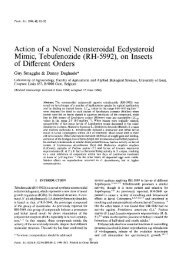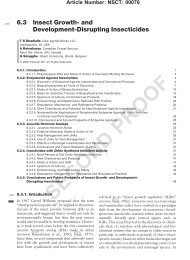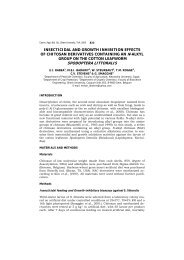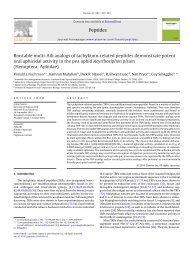Preference of cereal aphids for different varieties ... - Insects.ugent.be
Preference of cereal aphids for different varieties ... - Insects.ugent.be
Preference of cereal aphids for different varieties ... - Insects.ugent.be
Create successful ePaper yourself
Turn your PDF publications into a flip-book with our unique Google optimized e-Paper software.
Arthropod-Plant Interactions (2012) 6:345–350<br />
DOI 10.1007/s11829-012-9184-5<br />
ORIGINAL PAPER<br />
<strong>Preference</strong> <strong>of</strong> <strong>cereal</strong> <strong>aphids</strong> <strong>for</strong> <strong>different</strong> <strong>varieties</strong> <strong>of</strong> winter wheat<br />
Nathalie De Zutter • Kris Audenaert •<br />
Geert Haesaert • Guy Smagghe<br />
Received: 15 Novem<strong>be</strong>r 2011 / Accepted: 15 February 2012 / Published online: 3 March 2012<br />
Ó Springer Science+Business Media B.V. 2012<br />
Abstract This paper reports on the development <strong>of</strong> a<br />
simple and robust preference meter (developed in-house) to<br />
score the host choice <strong>be</strong>havior <strong>of</strong> apterous <strong>aphids</strong>. With this<br />
tool, the preferences <strong>of</strong> two important <strong>cereal</strong> <strong>aphids</strong> Sitobion<br />
avenae (Fab.) and Metopolophium dirhodum (Walker)<br />
were investigated against four <strong>different</strong> <strong>varieties</strong> <strong>of</strong> winter<br />
wheat (Triticum aestivum L.) with a <strong>different</strong> susceptibility<br />
<strong>for</strong> Fusarium head blight (FHB). Differences in the choice<br />
<strong>be</strong>havior <strong>of</strong> both aphid species were observed <strong>for</strong> <strong>different</strong><br />
wheat <strong>varieties</strong>. The preferred wheat variety <strong>of</strong> S. avenae<br />
and M. dirhodum was not the same. Also, both aphid<br />
species clearly had a <strong>different</strong>ial preference <strong>for</strong> seedlings<br />
and ears. Using seedlings, M. dirhodum was about 1.8<br />
times more rapid in making its choice than S. avenae. In<br />
separate experiments with ears, S. avenae was 4.5 times<br />
faster than in the experiments with seedlings. In the present<br />
study, we aim to highlight differences in preference<br />
<strong>be</strong>havior in relation to potential mechanisms <strong>for</strong> host<br />
selection.<br />
Keywords Apterae Cereal <strong>aphids</strong> Metopolophium<br />
dirhodum Sitobion avenae Variety preference Winter<br />
wheat<br />
Handling Editor: Ro<strong>be</strong>rt Glinwood.<br />
N. De Zutter G. Smagghe (&)<br />
Department <strong>of</strong> Crop Protection, Faculty <strong>of</strong> Bioscience<br />
Engineering, Ghent University, Coupure Links 653, 9000 Ghent,<br />
Belgium<br />
e-mail: guy.smagghe@<strong>ugent</strong>.<strong>be</strong><br />
N. De Zutter K. Audenaert G. Haesaert<br />
Faculty <strong>of</strong> Applied Bioscience Engineering, University College<br />
Ghent, Valentin Vaerwyckweg 1, 9000 Ghent, Belgium<br />
Introduction<br />
Wheat is one <strong>of</strong> the world’s most important food grains and<br />
satisfies a considerable part <strong>of</strong> the human nutritional needs<br />
(Bushuk 1998). In 2009, over 225 million hectares <strong>of</strong><br />
wheat were harvested which had a gross production value<br />
<strong>of</strong> more than $145 billion (FAOSTAT 2011). Nowadays,<br />
pre- and post-harvest infestations by insects are among the<br />
major constraints in the production <strong>of</strong> wheat.<br />
One <strong>of</strong> the major pests <strong>of</strong> wheat is the aphid (Hemiptera:<br />
Aphididae). These insects damage crops by feeding on the<br />
plant assimilates or by transmitting viruses. Two important<br />
species <strong>of</strong> wheat in NW Europe are Sitobion avenae (Fab.)<br />
(English grain aphid) and Metopolophium dirhodum<br />
(Walker) (rose-grain aphid). Since S. avenae first feeds on<br />
the leaves but later migrates to the ears after emergence,<br />
they are known as ear feeders (Wratten 1975). M. dirhodum<br />
prefers leaves and rarely moves to the ears (Nyaanga<br />
et al. 2006). This leaf feeder migrates to the flag leaf once<br />
the lower leaves start to senesce (Wratten 1975).<br />
<strong>Preference</strong> assays are imperative to delineate the<br />
importance <strong>of</strong> the host genotype in the <strong>be</strong>havior <strong>of</strong> <strong>aphids</strong><br />
when they have to choose <strong>be</strong>tween <strong>different</strong> host <strong>varieties</strong>.<br />
It also contributes to a judicious selection <strong>of</strong> wheat <strong>varieties</strong><br />
in order to avoid or limit aphid infestations and thus<br />
minimize yield losses.<br />
Plant chemicals can play a role in the host selection <strong>of</strong><br />
<strong>aphids</strong>. These chemicals are part <strong>of</strong> a defensive network<br />
protecting the plant from insect attack. For instance, Lushai<br />
et al. (1997) investigated the host selection <strong>of</strong> winged summer<br />
females <strong>of</strong> S. avenae. Their approach involved counting<br />
the progeny in host preference tests, from which they concluded<br />
that <strong>aphids</strong> preferred the agricultural host winter<br />
wheat more than its natural host cocksfoot (Dactylis glomerata<br />
L.). Although molecular mechanisms <strong>be</strong>hind this<br />
123
346 N. De Zutter et al.<br />
preference largely remain elusive, Nicol et al. (1992) pointed<br />
to a significant negative relationship <strong>be</strong>tween the proportion<br />
<strong>of</strong> alate S. avenae colonizing seedlings <strong>of</strong> <strong>different</strong> wheat<br />
<strong>varieties</strong> and the hydroxamic acid levels in those <strong>varieties</strong>.<br />
There is also a reasonable likelihood that volatile<br />
organic compounds (VOC) are important triggers <strong>for</strong><br />
choosing a host plant. Several studies corroborate the role<br />
<strong>of</strong> plant volatiles in the attraction <strong>of</strong> <strong>aphids</strong> to plants. For<br />
example, Quiroz and Niemeyer (1998) noticed an elicited<br />
attraction <strong>of</strong> the <strong>cereal</strong> aphid Rhopalosiphum padi L. to<br />
volatiles produced by wheat and oat seedlings. Although<br />
plants produce volatiles during their physiological development,<br />
biosynthesis <strong>of</strong> volatiles is especially triggered<br />
when fungal or bacterial plant pathogens infect and colonize<br />
plants (Cardoza et al. 2002; Huang et al. 2003; Obara<br />
et al. 2002; Toome et al. 2010; Vuorinen et al. 2007).<br />
The aphid preference also sheds light on the tritrophic<br />
interaction <strong>be</strong>tween wheat, <strong>cereal</strong> <strong>aphids</strong> and wheat fungi.<br />
Indeed, if <strong>cereal</strong> <strong>aphids</strong> like S. avenae and M. dirhodum prefer<br />
certain wheat <strong>varieties</strong> that are also susceptible to plant<br />
pathogenic fungi like Fusarium sp., both insects and fungi<br />
could interact resulting in a faster dispersal <strong>of</strong> fungal mycelium<br />
and spores. This has already <strong>be</strong>en descri<strong>be</strong>d <strong>for</strong> the<br />
orange wheat blossom midge (Sitodiplosis mosellana<br />
(Géhin)) and Fusarium graminearum (Schwa<strong>be</strong>) macroconidia<br />
(Mongrain et al. 2000). They recovered the fungus from<br />
the spikes <strong>of</strong> wheat plants that had <strong>be</strong>en exposed to artificially<br />
inoculated midges. On other plants, interactions <strong>be</strong>tween<br />
insects and fungal plant pathogens have already <strong>be</strong>en<br />
descri<strong>be</strong>d. For example, pea <strong>aphids</strong> Acyrthosiphon pisum<br />
(Harris) are a vector <strong>of</strong> Verticillium albo-atrum (Reinke and<br />
Berthold) on alfalfa (Medicago sativa L.) (Huang et al. 1981).<br />
Adult shore flies, fungus gnats and moth flies are vectors <strong>of</strong><br />
Fusarium avenaceum (Fr.:Fr.) Sacc. that causes Fusarium<br />
crown and stem rot on lisianthus (Eustoma grandiflorum Raf.<br />
(Shinn.)) (El-Hamalawi and Stanghellini 2005).<br />
In this paper, we report on an in-house developed<br />
preference meter that is simple, robust and used to investigate<br />
the preference <strong>be</strong>havior <strong>of</strong> apterous <strong>aphids</strong> <strong>of</strong> both<br />
M. dirhodum and S. avenae. With this bioassay, we<br />
investigated the preference <strong>of</strong> these two aphid species <strong>for</strong><br />
four winter wheat <strong>varieties</strong> with susceptibility to Fusarium<br />
head blight (FHB) ranging <strong>be</strong>tween susceptible, mild and<br />
tolerant. In a study <strong>of</strong> the LCG Belgium, a Flemish<br />
research center <strong>for</strong> grains, <strong>different</strong> wheat <strong>varieties</strong> were<br />
tested <strong>for</strong> their FHB susceptibility (Haesaert et al. 2009),<br />
indicating that Lexus was a susceptible variety and Sahara<br />
a tolerant variety. Homeros and Tulsa were moderately<br />
susceptible and moderately tolerant, respectively. Different<br />
parameters <strong>of</strong> the aphid preference <strong>be</strong>havior were scored.<br />
The <strong>varieties</strong> were compared at seedling level, and <strong>for</strong> S.<br />
avenae we also investigated the preference with regard to<br />
ears as this aphid species is descri<strong>be</strong>d to <strong>be</strong> ear attracted.<br />
Differences in preference <strong>be</strong>havior are discussed in relation<br />
to potential mechanisms <strong>for</strong> host selection and FHB susceptibility<br />
to <strong>be</strong> attractive <strong>for</strong> both aphid species.<br />
Materials and methods<br />
Test organisms<br />
Non-clonal cultures <strong>of</strong> S. avenae and M. dirhodum were<br />
maintained on wheat seedlings. They were encouraged to<br />
reproduce parthenogenetically under long-day conditions<br />
(LD 18:6) at a constant temperature <strong>of</strong> 22°C.<br />
Four <strong>varieties</strong> <strong>of</strong> winter wheat (Triticum aestivum L.)<br />
were used: Sahara (---), Tulsa (--?), Homeros (-??)<br />
and Lexus (???) where the (-) and (?) notations represent<br />
their susceptibility <strong>for</strong> FHB ranging from tolerant<br />
(---) to susceptible (???).<br />
Experimental design <strong>for</strong> preference tests<br />
To determine aphid preferences <strong>for</strong> wheat <strong>varieties</strong>, an<br />
experimental design was developed. This was achieved<br />
using a three-way connection linking two falcon tu<strong>be</strong>s to<br />
each other (Fig. 1a). Through the third opening <strong>of</strong> the<br />
three-way connection, ten apterous adult <strong>aphids</strong> were<br />
placed in the system using a small paint brush. All tests<br />
were per<strong>for</strong>med under long-day conditions (LD 18:6) at a<br />
constant temperature <strong>of</strong> 22°C.<br />
When the preference tests were conducted using 7-day-old<br />
seedlings, 15-ml falcon tu<strong>be</strong>s were used. Seeds were sterilized<br />
in 1% NaOCl <strong>for</strong> 1 min, washed in sterile water and put into<br />
4 g <strong>of</strong> sterile white sand with 0.5 ml <strong>of</strong> sterile water as shown<br />
a<br />
b<br />
c<br />
falcon tu<strong>be</strong><br />
place where <strong>aphids</strong> are inserted<br />
three-way connection<br />
Fig. 1 Setup <strong>of</strong> the binary choice experiment: a schematic view,<br />
b setup with seedlings, and c setup with ears<br />
123
<strong>Preference</strong> <strong>of</strong> <strong>cereal</strong> <strong>aphids</strong> <strong>for</strong> winter wheat <strong>varieties</strong> 347<br />
in Fig. 1b. The tu<strong>be</strong>s were sealed with parafilm and placed in a<br />
growth cham<strong>be</strong>r (22°C, 16/8 light/dark cycle).<br />
To per<strong>for</strong>m preference tests at the ear level, the top <strong>of</strong> a<br />
50-ml falcon tu<strong>be</strong> was cut <strong>of</strong>f in order to fit on the threeway<br />
connection. As depicted in Fig. 1c, the ear was put<br />
through the screw cap opening <strong>of</strong> the tu<strong>be</strong> which was<br />
afterward sealed with parafilm.<br />
<strong>Preference</strong> <strong>of</strong> <strong>cereal</strong> <strong>aphids</strong> <strong>for</strong> <strong>different</strong> wheat <strong>varieties</strong><br />
at the seedling level<br />
Binary choice experiments were conducted with seedlings <strong>of</strong><br />
the wheat <strong>varieties</strong> Sahara, Tulsa, Homeros and Lexus. After<br />
the <strong>aphids</strong> were put in the preference meter, their choice was<br />
scored every hour up to 7 h by counting the <strong>aphids</strong> on both<br />
seedlings (‘first variety’, ‘second variety’) and in the threeway<br />
connection (‘no choice made yet’). This was repeated<br />
after 24 h. Each combination was tested five times. The<br />
scores were analyzed using multinomial logistic regression<br />
in SPSS version 15.0 (Statistical Package <strong>for</strong> Social Sciences).<br />
This is an expansion <strong>of</strong> (binary) logistic regression<br />
when the outcome <strong>of</strong> the categorical dependent had more<br />
than two levels (Chan 2005). In this experiment, the<br />
dependent factor ‘choice’ had three levels: ‘first variety’,<br />
‘second variety’ and ‘no choice made yet’. A reference level<br />
(<strong>for</strong> example ‘first variety’) was chosen and the other groups<br />
(‘second variety’ and ‘no choice made yet’) were compared<br />
with this reference. This was followed by taking another<br />
reference (<strong>for</strong> example ‘second variety’) and compared again<br />
(with ‘first variety’ and ‘no choice made yet’). This was<br />
repeated until all levels were compared with each other.<br />
Significant differences were identified at P = 0.05.<br />
A second parameter was the speed <strong>of</strong> choice. For each<br />
combination, a graph was drawn with x-axis = time and<br />
y-axis = mean num<strong>be</strong>rs <strong>of</strong> <strong>aphids</strong> that had made a choice.<br />
A curve with a quadratic equation fitted these data points<br />
<strong>be</strong>st. The slope <strong>of</strong> this curve gave an indication <strong>of</strong> how<br />
quickly the <strong>aphids</strong> made their choice.<br />
<strong>Preference</strong> <strong>of</strong> S. avenae <strong>for</strong> <strong>different</strong> wheat <strong>varieties</strong><br />
at the ear level<br />
The combinations <strong>of</strong> Homeros–Homeros, Lexus–Lexus<br />
and Homeros-Lexus were investigated at the ear level with<br />
S. avenae <strong>aphids</strong> as shown in Fig. 1c. The ears had not yet<br />
reached anthesis GS 59 (Zadoks et al. 1974) and the<br />
combinations were again tested five times. Every hour, the<br />
level ‘no choice made yet’ was scored. Once all the <strong>aphids</strong><br />
had made a choice, they were counted by destroying the<br />
ears. The same analysis <strong>of</strong> preference and speed <strong>of</strong> choice<br />
was used as given above.<br />
Results<br />
<strong>Preference</strong> <strong>of</strong> <strong>cereal</strong> <strong>aphids</strong> <strong>for</strong> <strong>different</strong> wheat <strong>varieties</strong><br />
at the seedling level<br />
For both aphid species, significant differences in preference<br />
were found <strong>be</strong>tween the <strong>different</strong> winter wheat <strong>varieties</strong><br />
Fig. 2 Response in binary<br />
choice experiment at seedling<br />
level with <strong>different</strong> winter<br />
wheat <strong>varieties</strong> (Lexus,<br />
Homeros, Tulsa, Sahara) <strong>for</strong> M.<br />
dirhodum. a Choice <strong>be</strong>havior at<br />
seedling level over time.<br />
Different letters above the bars<br />
indicate a significant difference<br />
in preference <strong>be</strong>tween the wheat<br />
<strong>varieties</strong>. b Table with P values<br />
over all variety combinations;<br />
(-) and (?) indicate tolerance<br />
and susceptibility <strong>for</strong> FHB,<br />
respectively. c Average slopes<br />
(±SE) with speed <strong>of</strong> choice <strong>for</strong><br />
all <strong>varieties</strong> over time<br />
a<br />
# <strong>aphids</strong><br />
c<br />
slopes<br />
10<br />
9<br />
8<br />
7<br />
6<br />
5<br />
4<br />
3<br />
2<br />
1<br />
0<br />
Sahara<br />
no choice made yet<br />
Lexus<br />
c<br />
a<br />
b<br />
b<br />
a<br />
a<br />
b<br />
b<br />
a<br />
P=0.001<br />
a<br />
1h 4h 7h 24h<br />
time<br />
b<br />
b<br />
Sahara<br />
(---)<br />
2<br />
1.8<br />
1.6<br />
1.4<br />
1.2<br />
1<br />
0.8<br />
0.6<br />
0.4<br />
0.2<br />
0<br />
0 1 2 3 4 5 6 7<br />
time (h)<br />
Tulsa<br />
(- - +)<br />
Homeros<br />
(- + +)<br />
Lexus<br />
(+ + +)<br />
Sahara<br />
(- - -) 0.397 0.777 0.777 0.001<br />
Tulsa<br />
(- - +) 0.777 0.397 0.260<br />
Homeros<br />
(- + +) 0.777 0.209<br />
Lexus<br />
(+ + +) 0.777<br />
123
348 N. De Zutter et al.<br />
(Figs. 2b and 3b). After 24 h, M. dirhodum preferred Lexus<br />
over Sahara (P = 0.001) (Fig. 2a) and S. avenae showed<br />
significant preference <strong>for</strong> Tulsa over Lexus (P = 0.014)<br />
(Fig. 3a). S. avenae also preferred Tulsa over Homeros, but<br />
this observation was not conclusive (P = 0.062).<br />
When choosing <strong>be</strong>tween <strong>varieties</strong> at the seedling level,<br />
the average slope ± SE after 1 h was 1.37 ± 0.23 <strong>for</strong> M.<br />
dirhodum (Fig. 2c) and 0.76 ± 0.14 <strong>for</strong> S. avenae<br />
(Fig. 3c).<br />
<strong>Preference</strong> <strong>of</strong> S. avenae <strong>for</strong> <strong>different</strong> wheat <strong>varieties</strong><br />
at the ear level<br />
<strong>Preference</strong> tests at the ear level were conducted where the<br />
<strong>varieties</strong> <strong>of</strong> Homeros and Lexus were combined with each<br />
other and among themselves. As depicted in Fig. 4a, no<br />
significant preferences were found.<br />
The slope after 1 h over all combinations at the ear level<br />
<strong>for</strong> S. avenae was 3.45 ± 0.25 (Fig. 4b).<br />
Discussion<br />
To conduct preference tests, we developed a simple robust<br />
preference meter. This was constructed out <strong>of</strong> falcon tu<strong>be</strong>s<br />
and a three-way connection. Using this tool, tests were set<br />
up <strong>for</strong> <strong>cereal</strong> <strong>aphids</strong> S. avenae and M. dirhodum, which had<br />
to make a choice <strong>be</strong>tween two seedlings or ears <strong>of</strong> wheat<br />
<strong>varieties</strong> Sahara, Tulsa, Homeros or Lexus. If both aphid<br />
species could choose <strong>be</strong>tween the same wheat <strong>varieties</strong>,<br />
Fig. 3 Response in binary<br />
choice experiment at seedling<br />
level with <strong>different</strong> winter<br />
wheat <strong>varieties</strong> (Lexus,<br />
Homeros, Tulsa, Sahara) <strong>for</strong> S.<br />
avenae. a Choice <strong>be</strong>havior at<br />
seedling level over time.<br />
Different letters above the bars<br />
indicate a significant difference<br />
in preference <strong>be</strong>tween the wheat<br />
<strong>varieties</strong>. b Table with P values<br />
over all variety combinations;<br />
(-) and (?) indicate tolerance<br />
and susceptibility <strong>for</strong> FHB,<br />
respectively. c Average slopes<br />
(±SE) with speed <strong>of</strong> choice <strong>for</strong><br />
all <strong>varieties</strong> over time<br />
a<br />
# <strong>aphids</strong><br />
c<br />
slopes<br />
10<br />
9<br />
8<br />
7<br />
6<br />
5<br />
4<br />
3<br />
2<br />
1<br />
0<br />
b<br />
Tulsa<br />
no choice made yet<br />
Lexus<br />
P=0.014<br />
a<br />
a<br />
a<br />
a<br />
b<br />
ab<br />
b<br />
a<br />
b<br />
1h 4h 7h 24h<br />
time<br />
b<br />
b<br />
Sahara<br />
(- - -)<br />
2<br />
1.8<br />
1.6<br />
1.4<br />
1.2<br />
1<br />
0.8<br />
0.6<br />
0.4<br />
0.2<br />
0<br />
0 1 2 3 4 5 6 7<br />
time (h)<br />
Tulsa<br />
(- - +)<br />
Homeros<br />
(- + +)<br />
Lexus<br />
(+ + +)<br />
Sahara<br />
(- - -) 0.777 0.397 0.397 0.397<br />
Tulsa<br />
(- - +) 0.777 0.062 0.014<br />
Homeros<br />
(- + +) 0.777 0.260<br />
Lexus<br />
(+ + +) 0.777<br />
a<br />
Homeros<br />
(- + +)<br />
Lexus<br />
(+ + +)<br />
Homeros<br />
(- + +) 0.572 0.777<br />
Lexus<br />
(+ + +) 0.777<br />
b<br />
slopes<br />
5<br />
4.5<br />
4<br />
3.5<br />
3<br />
2.5<br />
2<br />
1.5<br />
1<br />
0.5<br />
0<br />
0 1 2 3 4 5<br />
time (h)<br />
Fig. 4 Response in binary choice experiment at ear level with<br />
<strong>different</strong> winter wheat <strong>varieties</strong> (Lexus and Homeros) <strong>for</strong> S. avenae.<br />
a Table with P values over all <strong>varieties</strong> combinations; (-) and (?)<br />
indicate tolerance and susceptibility <strong>for</strong> FHB, respectively. b Average<br />
slopes (±SE) with speed <strong>of</strong> choice <strong>for</strong> all <strong>varieties</strong> over time<br />
123
<strong>Preference</strong> <strong>of</strong> <strong>cereal</strong> <strong>aphids</strong> <strong>for</strong> winter wheat <strong>varieties</strong> 349<br />
there was no significant difference in choice found<br />
(P [ 0.05), which was reflected by an equal amount <strong>of</strong><br />
<strong>aphids</strong> present in both tu<strong>be</strong>s (Figs. 2b, 3b and 4a). This<br />
illustrates the pro<strong>of</strong> <strong>of</strong> concept. The distribution indicated<br />
an unbiased design, meaning that group <strong>be</strong>havior could <strong>be</strong><br />
ruled out. The choice <strong>of</strong> one aphid was not affected by the<br />
choice <strong>of</strong> another, <strong>be</strong>cause the remaining nine <strong>aphids</strong> did<br />
not all choose the variety that the first aphid had chosen.<br />
Significant preferences were found <strong>for</strong> both aphid species.<br />
Apterous M. dirhodum preferred the variety Lexus<br />
over Sahara and S. avenae preferred Tulsa over Lexus.<br />
These results indicated that preference was an intrinsic<br />
characteristic <strong>of</strong> <strong>cereal</strong> <strong>aphids</strong>, since both species did not<br />
prefer the same winter wheat variety. When seedlings <strong>of</strong><br />
Homeros and Lexus were combined, no significant difference<br />
in preference <strong>of</strong> S. avenae was found. The same<br />
combination at the ear level also showed no significant<br />
difference in preference.<br />
According to the slopes <strong>of</strong> the quadratic equation <strong>for</strong><br />
determining how quickly the <strong>aphids</strong> made their choice, M.<br />
dirhodum made their choice at the seedling level 1.8 times<br />
faster than S. avenae. Once again, this indicates intrinsic<br />
differences <strong>be</strong>tween the two aphid species. Although S.<br />
avenae <strong>aphids</strong> decided more slowly at the seedling level,<br />
they were able to make a choice 4.5 times faster at the ear<br />
level than the seedling level, indicating a preference <strong>for</strong><br />
ears over seedlings. Indeed, Wratten (1975) reported that<br />
<strong>aphids</strong> <strong>of</strong> S. avenae move rapidly to the ears when they<br />
emerge. However, more research is needed to make firm<br />
conclusions and to indicate the mechanisms <strong>be</strong>hind this<br />
<strong>be</strong>havior.<br />
The preference tests as presented in this project can<br />
contribute to a more reasoned choice <strong>of</strong> wheat <strong>varieties</strong> in<br />
order to lower aphid infestations. However, it should <strong>be</strong><br />
noted that this study did not investigate the nutritional<br />
influence <strong>of</strong> the <strong>different</strong> <strong>varieties</strong> on the <strong>aphids</strong>, or the<br />
influence on their reproduction. It only broadens our<br />
knowledge about aphid preference.<br />
There are several mechanisms that play a role in the<br />
choice <strong>be</strong>havior <strong>of</strong> <strong>aphids</strong>. Many studies demonstrate that<br />
olfactory cues play a role in host finding by <strong>aphids</strong>. The<br />
response <strong>of</strong> the two <strong>cereal</strong> <strong>aphids</strong> used in this project, S.<br />
avenae and M. dirhodum, <strong>for</strong> plant volatiles was examined<br />
in the study <strong>of</strong> Visser and Fu-shun (1995). With an electroantennogram,<br />
it was found that (E)-2-hexenal and hexanal<br />
elicit the largest responses in alate <strong>for</strong>ms <strong>of</strong> both <strong>aphids</strong>.<br />
However, while the corresponding alcohols elicited smaller<br />
responses <strong>for</strong> S. avenae, the contrast <strong>be</strong>tween the responses<br />
to aldehydes and alcohols were not so clear <strong>for</strong> M. dirhodum.<br />
Another layer <strong>of</strong> complexity in the olfactometric<br />
mechanism is that once <strong>aphids</strong> have settled on a host plant,<br />
the volatile blend <strong>of</strong> that plant can <strong>be</strong> altered, changing the<br />
decision <strong>of</strong> other <strong>aphids</strong> that have not yet settled. Quiroz<br />
et al. (1997) pointed out that volatiles <strong>of</strong> wheat seedlings<br />
infected with apterae <strong>of</strong> R. padi had a repelling effect and<br />
several compounds were identified from seedlings with a<br />
high aphid density, but not from the wheat seedlings alone.<br />
Another host selection mechanism is that <strong>aphids</strong> can<br />
visually discriminate <strong>be</strong>tween host and non-host targets.<br />
This was confirmed by Gish and Inbar (2006) <strong>for</strong> apterous<br />
Macrosiphoniella artemisiae <strong>aphids</strong>, which found their<br />
way back to the host plant after dropping from the plant.<br />
It is also possible that the aphid’s plant choice changes<br />
when detecting a certain chemical after initial probing.<br />
Nicol et al. (1992) pointed to a significant negative relationship<br />
<strong>be</strong>tween the proportion <strong>of</strong> alate S. avenae colonizing<br />
seedlings <strong>of</strong> <strong>different</strong> wheat <strong>varieties</strong> and the<br />
hydroxamic acid levels in those <strong>varieties</strong>.<br />
A remarkable observation in this project is that M. dirhodum<br />
prefers the most FHB-susceptible variety (Lexus) over<br />
the most FHB-tolerant one (Sahara). In contrast, S. avenae<br />
prefers Tulsa, a moderately tolerant variety, over the susceptible<br />
Lexus. Considering the experimental design we<br />
used in this project, we suggest that all mechanisms playing<br />
a role in host selection by <strong>aphids</strong> are taken into account.<br />
This means that if there were <strong>different</strong> wheat characteristics<br />
resulting from a <strong>different</strong> Fusarium susceptibility, they<br />
have <strong>be</strong>en taken into account in our preference meter.<br />
This project elucidates the distribution <strong>of</strong> fungal pathogens<br />
by <strong>aphids</strong> when they prefer an FHB-susceptible wheat<br />
variety. When more <strong>aphids</strong> are located on a plant, variety or<br />
plant part that is susceptible to a pathogen, there can <strong>be</strong> a<br />
greater risk <strong>for</strong> the distribution <strong>of</strong> that pathogen. For<br />
example, since M. dirhodum prefers the leaves <strong>of</strong> wheat,<br />
this aphid species is more likely to play a role in the distribution<br />
<strong>of</strong> leaf-living fungi such as Septoria sp. In contrast,<br />
the ear-feeding S. avenae can also <strong>be</strong> a distributor <strong>of</strong> earattacking<br />
fungi such as Fusarium sp. Although no clear link<br />
was observed <strong>be</strong>tween susceptibility <strong>of</strong> wheat to FHB and<br />
preference <strong>of</strong> <strong>aphids</strong> in the present study, it would <strong>be</strong> an<br />
oversimplification to state at this point that there is no<br />
preferential link <strong>be</strong>tween <strong>aphids</strong> and FHB-infected plants.<br />
To date, knowledge on plant alternations <strong>of</strong> susceptible<br />
<strong>varieties</strong> due to Fusarium infection is scarce, but likely to <strong>be</strong><br />
<strong>different</strong> from resistant <strong>varieties</strong>. In addition, evidence is<br />
accumulating that mycotoxins produced by mem<strong>be</strong>rs <strong>of</strong> the<br />
FHB disease complex can hijack the plant’s defense system<br />
(Desmond et al. 2008; Gardiner et al. 2010), and in this way<br />
influence the plant characteristics during the infection. A<br />
structural insight into tritrophic interactions is warranted to<br />
acquire a comprehensive view <strong>of</strong> the array <strong>of</strong> defenses that<br />
wheat can use against fungal and insect invaders. In this<br />
context, indirect evidence from the existence <strong>of</strong> tritrophic<br />
interactions arises from another model system. Shore fly<br />
adults (Scatella stagnalis (Fallen)) can contribute to the<br />
aerial dispersal <strong>of</strong> three soil-borne plant pathogens<br />
123
350 N. De Zutter et al.<br />
(Verticillium dahliae Kleb., Fusarium oxysporum<br />
Schlechtend.:Fr. f. sp. basilici (Dzidzariya) Armstr. and<br />
Armstr. and Thielaviopsis basicola (Berk. and Broome)<br />
Ferraris). Consonant with this observation, they are attracted<br />
to sporulating cultures <strong>of</strong> these pathogens and infected<br />
plant tissues (El-Hamalawi 2008). The latter example suggests<br />
that not only plant volatiles, but also fungal volatiles,<br />
might <strong>be</strong> involved in the preference <strong>of</strong> insects.<br />
In conclusion, the results <strong>of</strong> this project demonstrated<br />
that there are intrinsic differences <strong>be</strong>tween <strong>aphids</strong>, in terms<br />
<strong>of</strong> preference and speed <strong>of</strong> choice over <strong>different</strong> wheat<br />
<strong>varieties</strong> and aphid species, even when they occur on the<br />
same host plant. It was also demonstrated that the preference<br />
<strong>of</strong> M. dirhodum and S. avenae <strong>for</strong> wheat <strong>varieties</strong><br />
differs according to the FHB susceptibility.<br />
Acknowledgments The authors acknowledge support by the Special<br />
Research Council <strong>of</strong> Ghent University and would also like to<br />
thank Annelies De Roissart <strong>for</strong> her help in designing the preference<br />
meter. N.D.Z. is holder <strong>of</strong> a Ph.D. grant by the Agency <strong>for</strong> Innovation<br />
by Science and Technology in Flanders (IWT).<br />
References<br />
Bushuk W (1998) Wheat breeding <strong>for</strong> end-product use. Euphytica<br />
100:137–145<br />
Cardoza YJ, Alborn HT, Tumlinson JH (2002) In vivo volatile<br />
emissions from peanut plants induced by simultaneous fungal<br />
infection and insect damage. J Chem Ecol 28:161–174<br />
Chan YH (2005) Multinomial logistic regression. Singapore Med J<br />
46:259–269<br />
Desmond OJ, Manners JM, Stephens AE, Maclean DJ, Schenk PM,<br />
Gardiner DM, Munn AL, Kazan K (2008) The Fusarium<br />
mycotoxin deoxynivalenol elicits hydrogen peroxide production,<br />
programmed cell death and defense responses in wheat. Mol<br />
Plant Pathol 9:435–445<br />
El-Hamalawi ZA (2008) Attraction, acquisition, retention and<br />
spatiotemporal distribution <strong>of</strong> soilborne plant pathogenic fungi<br />
by shore flies. Ann Appl Biol 152:169–177<br />
El-Hamalawi ZA, Stanghellini ME (2005) Disease development on<br />
lisianthus following aerial transmission <strong>of</strong> Fusarium avenaceum<br />
by adult shore flies, fungus gnats and moth flies. Plant Dis<br />
89:619–623<br />
FAOSTAT (2011) Food and Agricultural Organization <strong>of</strong> the United<br />
Nations. http://faostat.fao.org/ (consulted 14-10-2011)<br />
Gardiner DM, Kazan K, Praud S, Torney FJ, Rusu A, Manners JM<br />
(2010) Early activation <strong>of</strong> wheat polyamine biosynthesis during<br />
Fusarium head blight implicates putrescine as an inducer <strong>of</strong><br />
trichothecene mycotoxin production. BMC Plant Biol 10:289<br />
Gish M, Inbar M (2006) Host location by apterous <strong>aphids</strong> after escape<br />
dropping from the plant. J Insect Behav 19:143–153<br />
Haesaert G, Derycke V, Heremans B, Audenaert K, Wittouck D,<br />
Willaert L (2009) Granen oogst 2009: ziekte<strong>be</strong>strijding wintertarwe<br />
(chapter 5, part 2). Book Landbouw Centrum Granen<br />
Vlaanderen vzw. p 194<br />
Huang HC, Harper AM, Kokko EG, Howard RJ (1981) Aphid<br />
transmission <strong>of</strong> Verticillium albo-atrum to alfalfa. Can J Plant<br />
Pathol 5:141–214<br />
Huang J, Cardoza YJ, Schmelz EA, Raina R, Engel<strong>be</strong>rth J, Tumlinson<br />
JH (2003) Differential volatile emissions and salicylic acid<br />
levels from tobacco plants in response to <strong>different</strong> strains <strong>of</strong><br />
Pseudomonas syringae. Planta 217:767–775<br />
Lushai G, Sherratt TN, David O, De Barro PJ, Maclean N (1997) Host<br />
selection by winged summer females <strong>of</strong> the aphid Sitobion<br />
avenae. Entomol Exp Appl 85:199–209<br />
Mongrain D, Couture L, Comeau A (2000) Natural occurrence <strong>of</strong><br />
Fusarium graminearum on adult wheat midge and transmission<br />
to wheat spikes. Cereal Res Commun 28:173–180<br />
Nicol D, Copaja SV, Wratten SD, Niemeyer HM (1992) A screen <strong>of</strong><br />
worldwide wheat cultivars <strong>for</strong> hydroxamic acid levels and aphid<br />
antixenosis. Ann Appl Biol 121:11–18<br />
Nyaanga JG, Kamau AW, Wanjama JK (2006) Niche and temporal<br />
differences in colonization <strong>of</strong> wheat <strong>varieties</strong> by three species <strong>of</strong><br />
<strong>cereal</strong> <strong>aphids</strong>. Asian J Plant Sci 5:713–716<br />
Obara N, Hasegawa M, Kodama O (2002) Induced volatiles in<br />
elicitor-treated and rice blast fungus-inoculated rice leaves.<br />
Biosci Biotechnol Biochem 66:2549–2559<br />
Quiroz A, Niemeyer HM (1998) Olfactometer-assessed response <strong>of</strong><br />
aphid Rhopalosiphum padi to wheat and oat volatiles. J Chem<br />
Ecol 24:113–124<br />
Quiroz A, Pettersson J, Pickett JA, Wadhams LJ, Niemeyer HM<br />
(1997) Semiochemicals mediating spacing <strong>be</strong>havior <strong>of</strong> bird<br />
cherry-oat aphid, Rhopalosiphum padi, feeding on <strong>cereal</strong>s.<br />
J Chem Ecol 23:2599–2607<br />
Toome M, Randjärv P, Copolovici L, Niinemets U, Heinsoo K, Luik<br />
A, Noe SM (2010) Leaf rust induced volatile organic compounds<br />
signalling in willow during the infection. Planta 232:235–243<br />
Visser JH, Fu-shun Y (1995) Electroantennogram responses <strong>of</strong> the<br />
grain <strong>aphids</strong> Sitobion avenae (F.) and Metopolophium dirhodum<br />
(Walk.) (Hom., Aphididae) to plant odour components. J Appl<br />
Entomol 119:539–542<br />
Vuorinen T, Nerg A-M, Syrjälä L, Peltonen P, Holopainen JK (2007)<br />
Epirrita autumnata induced VOC emission <strong>of</strong> silver birch differ<br />
from emission induced by leaf fungal pathogen. Arthropod Plant<br />
Interact 1:159–165<br />
Wratten SD (1975) The nature <strong>of</strong> the effects <strong>of</strong> the <strong>aphids</strong> Sitobion<br />
avenae and Metopolophium dirhodum on the growth <strong>of</strong> wheat.<br />
Ann Appl Biol 79:27–34<br />
Zadoks JC, Chang TT, Konzak CF (1974) A decimal code <strong>for</strong> the<br />
growth stages <strong>of</strong> <strong>cereal</strong>s. Weed Res 14:415–421<br />
123









